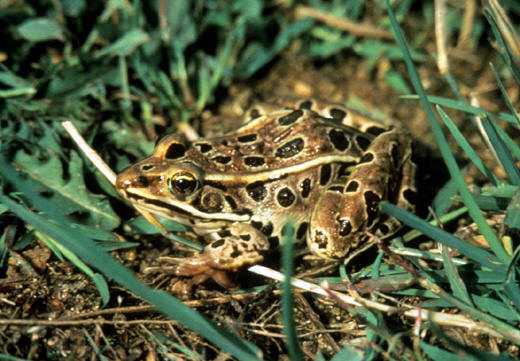Classification

Domain - Eukarya
Kingdom - Animalia
Phylum - Chordata
Subphylum - Verebrata
Class - Amphibia
Order - Anura
Suborder - Neobatrachia
Family - Ranidae
Genus - Rana
Species - Rana pipiens
Eukarya - The eukaryotes are that have a true
nucleolus and membrane-bound organelles
Animalia - These organisms are multicellular and
are heterotrophic. Most organisms in the Animalia kingdom are
motile and lack cell walls.
 Chordata
- The chordates all have vertebrates. They all share these
common features in at least one of their life cycles: a hollow
dorsal nerve cord, a notochord, a post-anal tail, and pharyngeal
slits.
Chordata
- The chordates all have vertebrates. They all share these
common features in at least one of their life cycles: a hollow
dorsal nerve cord, a notochord, a post-anal tail, and pharyngeal
slits.
Verebrata - These are organisms with backbones or
spinal columns.
Amphibia - (Amphi- means “on both sides and bios-
means “life) The amphibians are cold-blooded organisms that go
through some metamorphosis. Most amphibians lay their eggs in
water.
Anura - (An- means “without” and oura means
“tail”) The order Anura consists of the frog and toad population,
which can be identified by their webbed fingers and toes, absence of
tails, long hind legs, protruding eyes, and short bodies.
Neobatrachia - (literally means “new frogs”)
These organisms are considered to be the most advanced suborder and
the most apomorphic.
Ranidae - This family is also referred to as the
true frogs. The true frogs generally have smooth moist skin,
extensively webbed feet, and large powerful hind legs.
Rana - These true frogs are characterized
by their wrinkled skin and slim waists. They mostly live in
North America, Central America, northern half of South America, and
Eurasia.
Rana pipiens - (Rana means “frog” and
pipiens means peeping, this comes from the whistling sound that the
frog makes similar to the Spring Peepers) The Northern Leopard frog
can also be referred as Lithobates pipiens. This frog habitat
consists of parts of Canada and the United Stated.
This phylogenetic tree shows the taxonomic classification of a frog going from the class Amphibia to the order Anura.
This phylogenetic tree shows the taxonomic classification of a frog going from the order Anura to the suborder Neobatrachia to the family Ranidea.
Go Home, or continue to learn more about the Habitat and Geography of the Northern Leopard Frog.
Back to http://www.multipleorganisms.net



